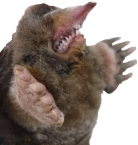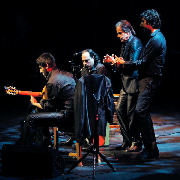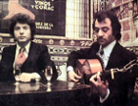Welcome to one of the most active flamenco sites on the Internet. Guests can read most posts but if you want to participate click here to register.
This site is dedicated to the memory of Paco de Lucía, Ron Mitchell, Guy Williams, Linda Elvira, Philip John Lee, Craig Eros, Ben Woods, David Serva and Tom Blackshear who went ahead of us.
We receive 12,200 visitors a month from 200 countries and 1.7 million page impressions a year. To advertise on this site please contact us.
|

|
|
RE: The Very Worst of the Mundo y Formas de Flamenco?
|
You are logged in as Guest
|
|
Users viewing this topic: none
|
|
Login  | |
|

   
NormanKliman
Posts: 1143
Joined: Sep. 1 2007

|
 RE: The Very Worst of the Mundo y Fo... (in reply to Guest) RE: The Very Worst of the Mundo y Fo... (in reply to Guest)
|
|
|
Flo: Glad you got through it alive, I know the feeling! I'm trying to get permission from someone to upload an excellent jaleos here but haven't heard back from the guy yet. BTW, I don't think anyone's mentioned that "jaleos" could also refer to a binary rhythm (a "tango extremeño").
Romerito:
quote:
I am sure you know this-I do not mean to sound like I am preaching down...
Thanks for taking the time to word it that way. It's just our opinions, and you know a lot of stuff that I don't. For example, you brought up a good point, although I don't agree completely. I think I know exactly which part of his book you're talking about: He mentions the chord voicings, with the first string being the fifth of the A chord and the tonic of the E chord, right? I wouldn't argue with Manolo, for a few different reasons  , but my own research leads me to conclude that the only determining factors are the range of the singer's voice and possibly (this one is very interesting for me) the other recordings that were made in the same session. I've come across more than a few cases that I thought were a bit odd because the capo was way up high. When I looked at the serial numbers of the recordings (the original "matrices," not the record company's catalogue numbers) I saw that, for example, the guitarist had already used granaínas toque three times, so instead of accompanying por granaína with the capo at the second fret (C sharp), he accompanied por Levante with the capo at the seventh fret. , but my own research leads me to conclude that the only determining factors are the range of the singer's voice and possibly (this one is very interesting for me) the other recordings that were made in the same session. I've come across more than a few cases that I thought were a bit odd because the capo was way up high. When I looked at the serial numbers of the recordings (the original "matrices," not the record company's catalogue numbers) I saw that, for example, the guitarist had already used granaínas toque three times, so instead of accompanying por granaína with the capo at the second fret (C sharp), he accompanied por Levante with the capo at the seventh fret.
But in those cases, I'm talking about the broad category of cantes levantinos (granaínas, malagueñas and tarantas, mineras, etc.) where there's a lot more flexibility in this sense. Still, I posted earlier this year a couple of falsetas from very old recordings where serrana is accompanied por medio and siguiriya is accompanied por arriba. (Thanks to mrMagenta for pointing that out, because I'd missed it!) Happens all the time in siguiriyas, but that serrana was a big surprise. In your favor, I'd have to admit that that serrana is the only por medio recording I've come across so far.
Maybe I'm talking about a few exceptions that confirm the rule (that confirm what you're saying). But if we analyze 100 different singers, we'll probably find that a lot them sing in a similar range. This is pretty much what I've found. There are high voices and low voices and the toques that go with them (granaína for the higher ones and Levante for the lower ones), but some keys happen very rarely (D or D sharp for example). In fact, there's one recording of Montoya accompanying with the toque de rondeña. It's the only one I've come across, the key is D sharp, and Montoya had already accompanied that singer with toque de granaína that same year. But this is getting off track. What I'm saying is that the codification that you mention is IMO just a natural consequence of the human voice that gets reinforced over time through repetition.
quote:
If it were only about cante then F# would be fine for Granaina and you will never hear that...
I don't want to sound like a know-it-all, but I think there are several factors to take into account to explain this. It's not easy to draw conclusions, but it looks to me like granaínas (cante) didn't become popular until well into the 20th century (1920s), and that coincided with the consolidation of toque de Levante for the cantes mineros. Before that guitarists were using toque de granaína and por arriba a lot more often to accompany the cante mineros. So my conclusion is that when granaínas became popular it gave guitarists a reason to reserve toque de granaínas for those cantes and to reserve toque de Levante for the cantes mineros. That helps to give these cantes their own characteristic sound and avoids the problem of repeating the same toque too many times on different recordings.
So I agree with most of what you're saying, but IMO (1) codification has more to do with natural consequences than "rules" of tradition, and (2) we have to take several factors into account if we want to take a guess at why guitarists accompanied with certain toques, and those factors are usually of a practical nature.
Ricardo:
Good one there, with Paco's soleá-caña; that's exactly what I was going to mention but didn't have a convenient reference at hand.
quote:
Who was that singer?
I looked at both videos but I don't know what singer you mean. What DVD?
BTW, starting to home in on Porrina's tarant@. I think you're right, the range isn't that unusual.
_____________________________
Be here now.
|
|
|
|
REPORT THIS POST AS INAPPROPRIATE |
Date Jan. 20 2010 10:08:41
 |
|

   
Ricardo
Posts: 14848
Joined: Dec. 14 2004
From: Washington DC

|
 RE: The Very Worst of the Mundo y Fo... (in reply to Guest) RE: The Very Worst of the Mundo y Fo... (in reply to Guest)
|
|
|
Without quoting either romerito or Norman, I would like to throw another idea in. I am basing my idea mainly on the early recordings of Ramon Montoya solo guitar, and Ramon accompanying Chacon.
I was very surprised to hear many cantes accompanied in key not normal for today's standards. I can't remember specifics, but things like Malagueñas accompanied in F#, Minera in Bphrygian, Cartagenera in B phrygian, etc....wish I could get all the details on that. The thing that stood out to me was that, at least in the old days, NO, the keys did not have anything to do with the accompaniment of the cante. Even the "aire" seemed "wrong" to me based on what I am now familiar with.
I would like to propose that it was after the GUITAR SOLO recordings, that the tonalities became more closely associated with the cantes. Because Montoya needed a title for pieces on his album, he used palo names, but NOT necessarily because one would have to accompany in those keys. Example "minera"....was always ok to do in F#. After the guitar solo in G# the name stuck to what the guitar does. Granaina-B, Malagueña -E, etc...man I don't know which malagueña of Chacon was accomp. in E but it seemed like NONE Of them!  
But now, all of em are accomp. in E, with Monotya's signature lines from his solo piece. Then you have mixing of granaina and Malagueña cantes and you have the guitar play in just one key. Again, I feel it just points to the fact the associated keys are incidental because of Montoya's solo guitar song titles. Things like Rosas too. Just names, not necessarily the cante melody.
And the final, most obvious example is his Rondeña. I really feel he was just picking names that have stuck now a days, but cante could be accompanied in whatever key or range or tonality best suited the voice.
Again guys this is just my idea based on these few recordings. To hear several older examples that codify tonality to the actual cantes would be interesting, cuz then I would have to ask what the HELL was Montoya thinking when he recorded with Chacon???
Also if you guys think I am way off, I will dig out that Chacon anthology and give a play by play of what I am hearing interm of tonalities... The guitar is pretty muddy, but the falsetas and voicings give away the keys to my ear.
Ricardo
_____________________________
CD's and transcriptions available here:
www.ricardomarlow.com
|
|
|
|
REPORT THIS POST AS INAPPROPRIATE |
Date Jan. 22 2010 7:12:45
 |
|
 New Messages New Messages |
 No New Messages No New Messages |
 Hot Topic w/ New Messages Hot Topic w/ New Messages |
 Hot Topic w/o New Messages Hot Topic w/o New Messages |
 Locked w/ New Messages Locked w/ New Messages |
 Locked w/o New Messages Locked w/o New Messages |
|
 Post New Thread
Post New Thread
 Reply to Message
Reply to Message
 Post New Poll
Post New Poll
 Submit Vote
Submit Vote
 Delete My Own Post
Delete My Own Post
 Delete My Own Thread
Delete My Own Thread
 Rate Posts
Rate Posts
|
|
|
Forum Software powered by ASP Playground Advanced Edition 2.0.5
Copyright © 2000 - 2003 ASPPlayground.NET |
0.09375 secs.
|


 Printable Version
Printable Version




 , but my own research leads me to conclude that the only determining factors are the range of the singer's voice and possibly (this one is very interesting for me) the other recordings that were made in the same session. I've come across more than a few cases that I thought were a bit odd because the capo was way up high. When I looked at the serial numbers of the recordings (the original "matrices," not the record company's catalogue numbers) I saw that, for example, the guitarist had already used granaínas toque three times, so instead of accompanying por granaína with the capo at the second fret (C sharp), he accompanied por Levante with the capo at the seventh fret.
, but my own research leads me to conclude that the only determining factors are the range of the singer's voice and possibly (this one is very interesting for me) the other recordings that were made in the same session. I've come across more than a few cases that I thought were a bit odd because the capo was way up high. When I looked at the serial numbers of the recordings (the original "matrices," not the record company's catalogue numbers) I saw that, for example, the guitarist had already used granaínas toque three times, so instead of accompanying por granaína with the capo at the second fret (C sharp), he accompanied por Levante with the capo at the seventh fret. 

 ) intro some time ago...
) intro some time ago... 
 ...i hope u get it...looking foward to it
...i hope u get it...looking foward to it 



 New Messages
New Messages No New Messages
No New Messages Hot Topic w/ New Messages
Hot Topic w/ New Messages Hot Topic w/o New Messages
Hot Topic w/o New Messages Locked w/ New Messages
Locked w/ New Messages Locked w/o New Messages
Locked w/o New Messages Post New Thread
Post New Thread